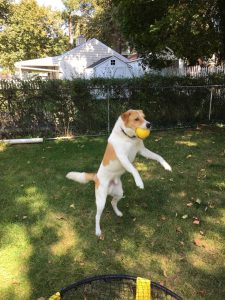I had the pleasure of meeting with Ms. Jones about her rescue dog, Drew. He is adorable!  I learned much about his rescue and his relationship with other dogs and humans. Drew is a rescue so there is no exact known breed to him. After speaking with her, I focused my research and interview learning about how he acts due to being a rescue dog and his different behaviors. Drew loves playing fetch with frisbees, and even lays down, sits, and rolls over when asked! He can even catch balls off a trampoline!!
I learned much about his rescue and his relationship with other dogs and humans. Drew is a rescue so there is no exact known breed to him. After speaking with her, I focused my research and interview learning about how he acts due to being a rescue dog and his different behaviors. Drew loves playing fetch with frisbees, and even lays down, sits, and rolls over when asked! He can even catch balls off a trampoline!!
When Drew was first being adopted by Ms. Jones, he was one of 12. The breeder told them they he was very good around people and especially with other dogs and did not bark much. This was exactly what she wanted so she was happy to find the perfect match. She soon found that this information was false. He was barking at everything and didn’t have great connections with other humans besides Ms. Jones.
After asking Ms. Jones why she thinks he was so different to the description he was given, she said that maybe it was because he had lived around 12 other dogs and was comfortable there because he didn’t have to be in charge of defending his care-givers. But all that changed when he was in the only dog in his new house. This type of behavior was continued at their local park.
The park is one of Drew’s favorite places, but Ms. Jones never knew if he is trying to fight or play with other dogs. Drew always got along with the other dogs at the park, and loved being around them. When there would be tussles with other dogs, Ms. Jones would get worried that he was going to get involved, but he never did.
He was constantly barking and playing around with the other dogs. He loved it! After one dog jumped on Drew’s back, he got involved, they were all told to go to behavioral camp. This wasn’t a problem and Drew was amazing at the camp. Drew attended the camp and was so good throughout the whole thing. He was even used as the example to the poor behaved dogs, showing how good of a job he was doing. A few weeks later at the park he was running at the same time a women with short hair threw a ball, and we think Drew thought she was hitting him, so he nipped her leg.
Drew focuses most of his energy towards Ms. Jones. While she doesn’t know about Drew’s abuser, she thinks it was a man that often wore hats. Drew gets easily triggered around people with these features. Unsurprisingly, the woman that Drew nipped at the park was a woman with very short hair and had a hat on.
After doing research, I learned about a behavior problem that are common in rescue dogs and found one called Hip Dysplasia. This behavior problem talks about not getting the attention they are used to, when in a stable home, and barking constantly. These were some of the descriptors that Mr. Jones gave me.
I was very interested in hearing about how Drew was very different than how he was presumed to be. After reading the article, Do Behavior Assessments in a Shelter Predict the Behavior of Dogs Post-Adoption? I learned about different behaviors. This article discusses the different kinds of studies they did on dogs that had formerly been abused and what they are like now, after being adopted. This relates to Ms. Jones’s dog because Drew is in a similar situation. He is very different than how he was described. It would be interesting to see if Drew was a study case and got reviewed before and after he was adopted by a loving family, after living an awful home. There were tests run on how the dog acted after being admitted, and then a month after they were in a stable home. Some dogs adapt quicker than others when leaving an abusive home and settling for a much safer home.
Although Drew is not the dog the Ms. Jones expected, she still loves him very much and he is a very happy dog!! He is great with tricks and loves his treats. His favorite being cheese that’s hidden around the house.
Works Cited:
Clemons, G. L. (1997, March 19). Behavior problems frequently seen in rescue animals. Retrieved September 29, 2020, from http://www.naiaonline.org/articles/article/behavior-problems-frequently-seen-in-rescue-animal
Clay, L., Paterson, M., Bennett, P., Perry, G., & Phillips, C. (2020, July 18). Do Behaviour Assessments in a Shelter Predict the Behaviour of Dogs Post-Adoption? Retrieved September 30, 2020, from https://www.mdpi.com/2076-2615/10/7/1225

Leave a Reply